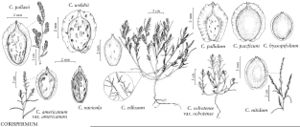Corispermum pallasii
Mém. Soc. Imp. Naturalistes Moscou 5: 336. 1817.
Plants branched from base or nearly so, 10–45 (–60) cm, sparsely covered with dendroid or almost stellate hairs, becoming glabrous. Leaf-blades linear-lanceolate, linear, or occasionally narrowly linear, usually plane, 1.5–4 × (0.1–) 0.2–0.4 (–0.5) cm. Inflorescences usually compact and dense, rarely ± lax and interrupted in proximal 1/2, clavate, narrowly clavate, or almost ovate in outline. Bracts ovate or ovatelanceolate (rarely narrowly ovatelanceolate), ca. (0.5–) 1–3 × 0.4–0.8 cm. Perianth segment 1. Fruits light-brown, brown, dark-brown, or deep olive green, often with reddish-brown spots and whitish warts, convex abaxially, usually plane or slightly concave adaxially, obovate or obovate-elliptic, usually broadest beyond middle, (3.2–) 3.5–4.5 (–4.7) × (2–) 2.4–3 mm; wing translucent only at margin (or in marginal 1/2), thick, 0.2–0.4 (–0.5) mm wide, margins entire or indistinctly erose, apex broadly triangular, rarely rounded or very indistinctly emarginate.
Phenology: Flowering late summer–fall.
Habitat: Sand dunes, sandy and gravely shores, waste places
Elevation: 0-100 m
Distribution
Alta., Man., Ont., Que., Sask., Ill., Ind., Mich., Minn., N.Y., N.Dak., Ohio, Wis., in Europe, Asia (se Siberia)
Discussion
Corispermum pallasii is placed in subsect. Pallasiana Mosyakin, which is evidently of Asian origin. Related taxa are widespread in southern Siberia, central Asia, Mongolia, and China. It is also widespread in Europe, where it was most probably initially introduced in Germany by German botanists and gardeners, who obtained seeds from Siberia through Russian botanical gardens (G. F. Schnittspahn 1851; U.-V. Köck 1986). In Europe this species was known as C. leptopterum (Ascherson) Iljin. It is not known yet whether this species was introduced to North America or is at least partly native within its North American range. Judging from the very close taxonomic affinity of C. pallasii to other, native North American taxa (e.g., C. americanum, C. villosum, C. ochotense, C. hookeri) and morphological similarity of its fruits to some fossil Corispermum fruits, the hypothesis of the native status of C. pallasii in North America seems to be preferable; secondary introduction of some populations from Europe is also not improbable.
Selected References
None.
